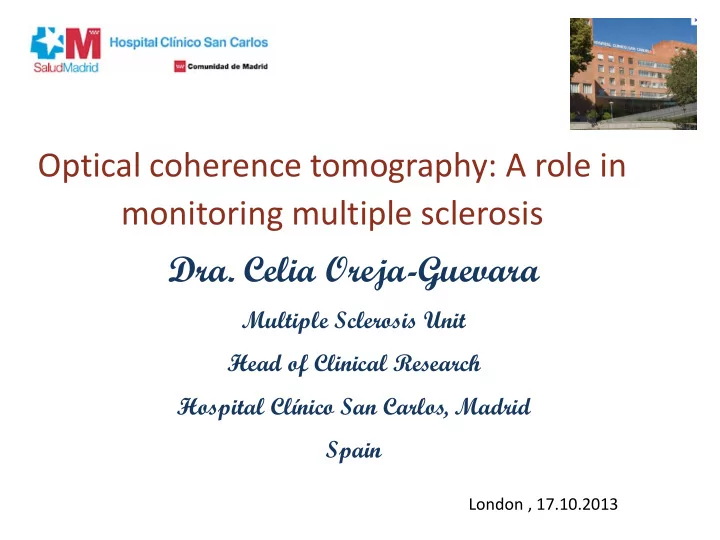

Optical coherence tomography: A role in monitoring multiple sclerosis Dra. Celia Oreja-Guevara Multiple Sclerosis Unit Head of Clinical Research Hospital Clínico San Carlos, Madrid Spain London , 17.10.2013
Optical coherence tomography • Quick, non-invasive, quantitative, reproducible, cheap technology • High resolution images • Correlation with clinical parameters • Sensible to longitudinal changes • Creates precise image of retinal structures • Enables the quantification of axonal and neuronal layers of the retina
The OCT is useful to quantify the thickness of retinal nerve fiber layer (RNFL) and the macula. The spectral-domain OCT (fourth generation) is capable of visualizing and quantifying specific layers of the retina with impressive precision. The use of OCT to quantify axonal loss is a promising tool to evaluate the disease progression in MS.
Visual pathway Retinal Nerve Fiber Layer (RNFL)
EVIDENCES OF LOSS OF RNFL The loss of RNFL is confirmed in Healthy volunteers different studies: - In vivo (Saidha et al, Brain 2011; Syc et al., Brain 2011) - in animals(Levkovitch et al. 2001) - electrophysiological (Davison et al., 1982; Kaufman et al. 1985) - Postmortem (Green, 2010; Kerrison et al., 1994) Green. Et al, Brain 2010
Prospects for OCT in MS – biomarker of disease prognosis – monitoring disease course – Defining response to therapy
OCT can measure (colour code) : - Acute phase: papiledema = RNFL - Chronic phase: RNFL There is a predominance temporal quadrant . The thickness of RNFL by month 3 (stable> 6 mo.) • RNFL thickness by mo. 6 predicts disability (<75 μm )
OCT normal Pathological OCT
Pathological OCT OCT normal
EXPLORATION OF MACULA
First OCT study in MS Significant reduction of RNFL thickness among the ON-eyes, MS- eyes and healthy controls. There is a correlation between PERG changes and NFL thickness in MS patients previously affected by optic neuritis, but there is no correlation between VEP changes and RNFL thickness Parisi, 1999 Meta-analysis ( 32 studies, Petzold et al., Lancet 2010) RNFL average in healthy controls 105 µ m MS-ON vs HS -20,38 µ m MS without ON vs HS -7,08 µ m
OCT IN OPTIC NEURITIS
AXONAL LOSS IN MS EVEN WITHOUT ACUTE ON G1: NO, G2: EM+NO , G3: EM Oreja-Guevara C et. al, 2010 Fisher, 2007 Pulicken, 2007
AXONAL LOSS IN ALL SUBTYPES OF MS Pulicken, 2007 Henderson et al., Brain 2008
2012
RNFL thickness is linked to disease activity in patients with Multiple Sclerosis • Patients who experienced relapses had a significantly thinner average RNFL compared with those who remained relapse-free over a 2-year period • Patients who had disease progression had a significantly thinner temporal RNFL compared with those who remained progression- free* over 2 years Toledo J et al . Mult Scler 2008
RNFL thickness is linked to progresion in MS The degree of RNFL atrophy was correlated with cognitive disability, mainly with the symbol digit modality test (r = 0.754, P < 0.001). Moreover, temporal quadrant RNFL atrophy measured with OCT was associated with physical disability. Neurology, Toledo, 2008
RNFL thickness is linked to progresion in MS Fisher, 2007
Patients with more relapses, more new gd lesions and new T2 lesions had faster rates of annualized GCIP thinning. Macular GCIP thinning is more closely associated with radiologic and clinical measures of MS progression than is RNFL thinning.
Correlation between RNFL and brain atrophy The thickness of RNFL is associated with the BPF (Gordon et al., 2007) Gordon ,2007
What happens to the RNFL over time in MS? Ann Neurol. 2010 June ; 67(6): 749 – 760
Current trials using OCT • MSC • Fingolimod (safety) • Ocrelizumab RRMS • Anti -Lingo (AON) • NT-KO-003 • AON (fingolimod)
Clinical trial monitoring with MS Decrease in retrobulbar diameter of the optic nerve was smaller in the erythropoietin group Suhs et al., Ann neurol 2012
The eyes with an RNFL measure between 60 to 80 μm had the highest response rate.
Rachel Nolan, BA* Jeffrey M. Gelfand, MD* Ari J. Green, MD, MCR Neurology,2013
Conclusions OCT is a promising imaging technique for monitoring axonal damage in MS. OCT can identify subtle changes in RNFL and macula over time. OCT measurements seem to correlate with clinical and MRI parameters. It is a candidate biomarker for becoming a surrogate end-point in clinical trials of MS.
THANK YOU
Recommend
More recommend